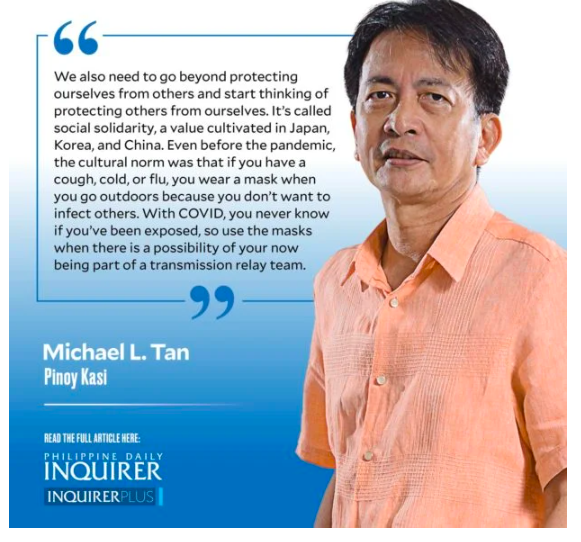To mask or not to mask

I recently stumbled on a YouTube post showing a government press conference. Sitting shoulder to shoulder were several officials to be interviewed. None had masks on. It was a classic example of a common misconception around COVID-19 risk: indoors you’re safe, and outdoors you’re in danger.
Finally, we now hear of plans not to require masks outdoors, which I hope will be accompanied by explanations that exposure risks are higher indoors rather than outdoors. Health authorities began to remove the mask requirement for outdoor settings as early as 2020, a few months into the pandemic. The scientific evidence was clear, that early, that even if the virus is airborne, it can’t quite survive outdoors given the winds and distances between people.
Having said that, note that the “indoors/outdoors” (or in Filipino, loob/labas) distinction might be deceptive. If you are outdoors and in a crowd where people are shoulder to shoulder, as we had during the election campaigning a few months ago, you still have exposure risk.
Conversely, you might be one of those workaholics who report to the office even after working hours. If you do that and you are all alone, using a mask is not only unnecessary but silly.
Removing the requirement for masks for outdoor settings is strongly supported by science but we need to keep going back to basics: beyond the outdoor/indoor distinction, we still have to remember the people factor, i.e., the virus is spread by people.
The Japanese 3Cs (sanmitsu in Japanese) is the best guide yet, with COVID-19 prevention revolving around three situations to avoid: crowds, confined spaces (kulob in Filipino), and close social encounters (lack of physical distancing when speaking or, worse, shouting and singing). Given that guide, we can understand why masks will continue to be required when we take public transport, not just inside the vehicle but while we’re waiting for the ride with many other people.
Think of the virus as being similar to track and field relay events. Are you in a situation where the virus can “jump” from one person to another to reach you? This is why I continue to be extra cautious when eating out. We have to take down our masks to eat but if you are seated shoulder to shoulder as in a carinderia (or in a plane), I would think twice about exposure risk. I avoid noisy restaurants, too, imagining the virus transformed into a cheering squad performing gymnastics and calisthenics!
The new guidelines on masking will, I hope, be tied to the levels of infection. If we see a resurgence of infections to high levels, masking outdoors might be required again, until the levels subside. Think of the parallels to typhoons: you don’t need raincoats and umbrellas if there’s no rain at all, or if there are only showers.
I must say I do worry about the culture-as-habit angle. Let’s face it: after more than two years of the pandemic, many of us haven’t quite made masks part of our routines. Imagine what could happen. Going out? We presume no need to bring a mask. But what if you end up in a crowd, or in a room with bad air circulation, or meet up with long-lost friends, all wanting to hug and peck (I’m referring to beso). Make the scouting motto “laging handa,” always prepared, a habit, and bring masks always, for yourself and friends or relatives, when leaving the house. I stash a supply, always, in the car.
We also need to go beyond protecting ourselves from others and start thinking of protecting others from ourselves. It’s called social solidarity, a value cultivated in Japan, Korea, and China. Even before the pandemic, the cultural norm was that if you have a cough, cold, or flu, you wear a mask when you go outdoors because you don’t want to infect others. With COVID, you never know if you’ve been exposed, so use the masks when there is a possibility of your now being part of a transmission relay team.
It’s social solidarity that stops us from spitting anywhere and everywhere. Or learning to cough into our elbow rather than into our hands. Also washing or spritzing sanitizer on our hands that were used to cover our coughing. And using masks. All that is social solidarity tied to life-saving respiratory etiquette.
mtan@inquirer.com.ph
For more news about the novel coronavirus click here.
What you need to know about Coronavirus.
For more information on COVID-19, call the DOH Hotline: (02) 86517800 local 1149/1150.
The Inquirer Foundation supports our healthcare frontliners and is still accepting cash donations to be deposited at Banco de Oro (BDO) current account #007960018860 or donate through PayMaya using this link.
The post To mask or not to mask appeared first on Cebu Daily News.

No comments: